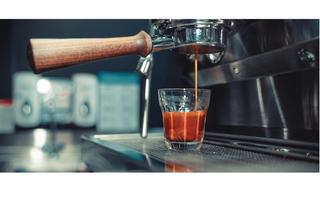I’ve mentioned elsewhere that the secret to making great decaf is an obsessive level of care and attention at every step in the coffee process. It can’t be done without farmers that are dedicated to producing and processing outstanding coffee cherries and the decaffeination process needs to prioritise freshness and the preservation of the original character of the coffee so that it can be roasted to optimal deliciousness. But all this hard work will be wasted if the coffee isn’t brewed properly. The following is a high-level overview of how to brew better espresso using decaf. As with all things coffee related, there’s a rabbit hole we can venture down, but I’ll save that for another day.
Where do we start?
Brewing better decaf starts with understanding that decaf behaves slightly differently to caffeinated coffee, both during the grinding process and the brewing process. Most importantly, decaf extracts differently to regular coffee.
What is extraction?
Extraction is the most important concept in brewing coffee. Simply put, hot water is passed through ground coffee to extract the water soluble compounds from inside the coffee, to give us those delicious coffee flavours that we all know and love. But like Goldilocks, we don’t want too little or too much extraction - it needs to be just right. Too little and our coffee will taste sour and too much will cause our coffee to taste bitter. This is because the fruit acids in coffee are easier to extract than the sugars. If you under extract the coffee, you won’t have extracted all the sugars and if you over extract the coffee, you end up with the heavier organic compounds that make your coffee taste bitter and gross.
How does decaffeinated coffee affect extraction?
One of the effects of the decaffeination process is to make the coffee easier to extract, which might sound like a good thing but can lead to over extraction and a bitter tasting cup of coffee. No bueno!
The other effect of decaffeination is that it decreases the amount of water soluble compounds that are present in the coffee, primarily because caffeine is a water soluble compound. So if you’ve read this far, you can see the issue that the home barista is faced with - coffee that is simultaneously easier to extract while there is less to extract.
What adjustments should we make to brew better tasting decaf coffee?
Because we know that there is less soluble material to extract in the first place, we can adjust for that by increasing the ratio of coffee to water, either by increasing the amount of ground coffee we use or reducing the amount of water - or a little of both. Typically I aim to reduce the amount of water that I put through the ground coffee by about 15%.
The second adjustment we should make is how long the coffee spends in contact with the water, as this has a big impact on extraction. My typical espresso recipe calls for a 30 second shot. When I brew decaf, my target time is in the 25-27 seconds range. If you’re wondering how to control the length of your extraction on a home espresso machine, the answer is to adjust the grind.
A few notes on grinding decaf coffee for a home espresso machine
I mentioned earlier that decaf coffee behaves differently when being ground. What that means for the home barista is that you may find that your decaf shots run more quickly than your caffeinated coffee shots when grinding both at the same setting. Whether you need to adjust your grind will depend on how much quicker the shot is running. My advice is to start by grinding your decaf the same as your caffeinated coffee and time how long it takes to get your desired yield. If it runs a little quicker, say 25-28 seconds, then no need to adjust your grind. If on the other hand the shot races out in less than 24 seconds, you should grind a little finer. Make a small adjustment each shot until you hit that Goldilocks moment.
Home Espresso Machine Recipe: Decaf
Dose: 20 grams (this will depend on the size of your basket - use the ratio to find the right dose for your machine)
Yield: 37 grams (the optimal yield can vary so try anywhere from 34-38 grams)
Time: 25-28 seconds
Ratio: 1:1.85
This is only a guide - it’s a good starting point, but if you taste your shots and adjust up and down slightly, you’ll be able to find where the coffee tastes best on your set-up. There’s no substitute for tasting and evaluating the coffee in order to find the ideal extraction. Decaf espresso should be sweet, have a mild and pleasant acidity (not sour) and shouldn’t be overly bitter. I hope this article helps you brew a better tasting cup of coffee.
